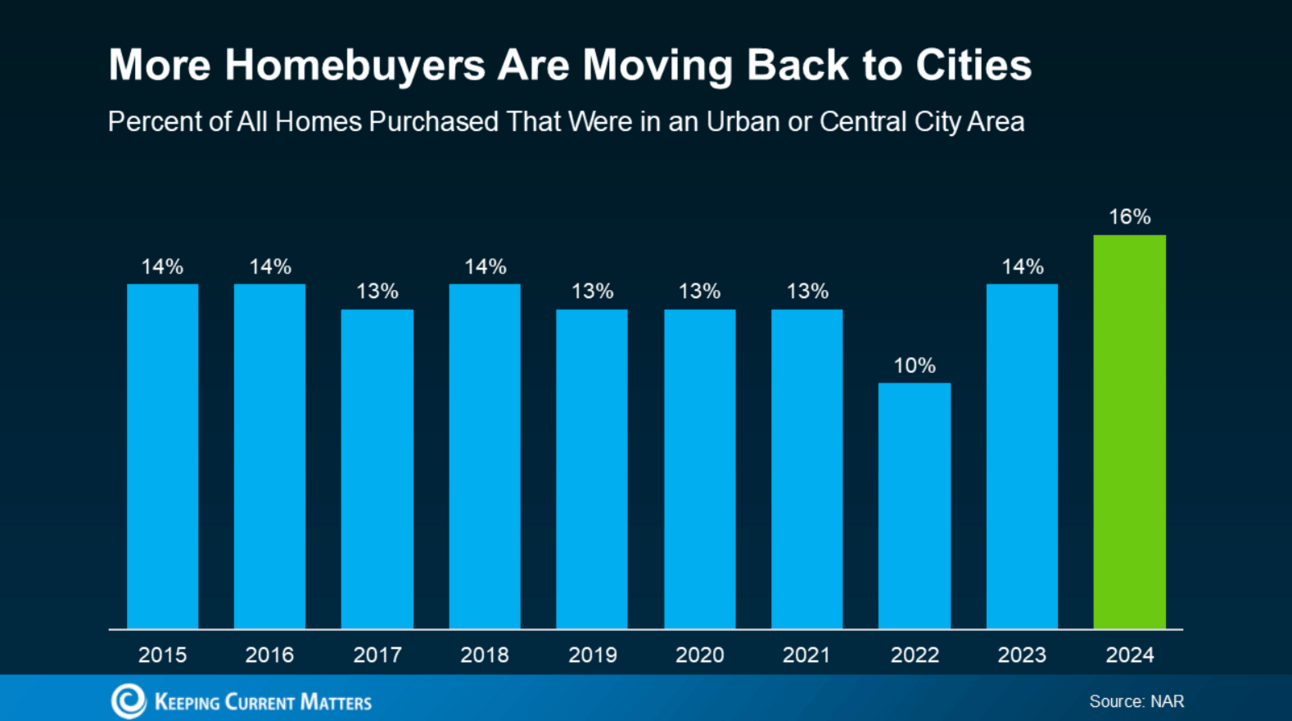We appreciate each and every one of you for taking the time to read Market Minds. Buckle up and enjoy the free value, and you’ll understand why over 60 NBA players have visited this week’s home…
Why the Smart Money is Moving Back to Cities

The pendulum is swinging back. After a mass exodus to the suburbs and rural retreats during the pandemic, cities are reclaiming their gravitational pull. According to the National Association of Realtors (NAR), the percentage of people moving to urban areas has hit 16%—the highest in a decade. Meanwhile, BrightMLS reports that 1 in 5 buyers actively want to live in a city.
That’s not just a trend; it’s a signal. The market is shifting, and the winners will be the ones who see what’s happening beneath the surface.
The Hybrid Work Reality Check
The pandemic dream of permanent remote work has faded. Hybrid models are becoming the norm, and proximity to the office is once again a valuable asset. Living an hour outside the city isn’t as appealing when the boss expects you in three days a week.
This shift is already showing up in rent and price appreciation in urban cores. High-demand neighborhoods are seeing increased competition, while exurban areas that once saw skyrocketing growth are stabilizing—or in some cases, softening.
Urban Inventory is Scarce—And That’s an Opportunity
The biggest challenge? Inventory. Cities weren’t overbuilt during the pandemic like the suburbs, and zoning restrictions continue to keep supply tight. That’s why urban home prices remain resilient despite higher mortgage rates.
Meanwhile, suburban homeowners who bought at ultra-low interest rates are sitting on significant equity gains—57.4% on average over the last five years, per the FHFA. Some are cashing out, downsizing, and returning to city life, betting that urban appreciation has more room to run.
Multifamily is Heating Up—Again
With affordability concerns still weighing on buyers, urban rental demand is surging. Rents in key metro areas are climbing, vacancy rates remain low, and institutional investors are once again eyeing multifamily properties. The narrative that “no one wants to live in the city” has officially expired.
The Buyer’s Market That Doesn’t Feel Like One

The data says it’s a buyer’s market. The reality? It’s more complicated.
With 3.7 months of housing supply on the market—the highest level in six years—the numbers suggest buyers should be in control. Homes are sitting longer, sellers are cutting prices, and negotiations are back in play. But for many, it still doesn’t feel like a win.
Why? Because while supply has increased, affordability remains brutal. Mortgage rates are still elevated, and home prices haven’t corrected the way many expected. That tension is creating one of the most unusual “buyer’s markets” in recent memory.
The Shift is Real, But It’s Uneven
Not all markets are moving at the same speed. The Sun Belt—especially Florida—is tilting heavily in favor of buyers. Cape Coral, Miami, and Fort Lauderdale are seeing months of supply climb into the double digits. That’s not just a shift; that’s a power swing. Sellers are realizing they missed the peak and are either adjusting or sitting on stale listings.
Meanwhile, upstate New York is a different story. Rochester and Buffalo are still seller-friendly, with lower inventory and resilient demand. This is what happens when the market moves out of sync—some places are oversupplied while others remain tight.
Sellers Are Learning to Play Ball
This is the first time in years that sellers are coming to the table with something other than arrogance. The typical home sold for 1.8% below the final asking price in January—the biggest discount in nearly two years. And deals are falling apart at the highest rate since 2017, which means buyers are walking away when they don’t get what they want.
It’s a simple equation: More inventory = more options = more negotiating power.
The Window Won’t Stay Open Forever
If the market was truly broken for sellers, they’d be pulling homes off the market en masse. But they’re not. Many are accepting reality, pricing more aggressively, and cutting deals. And once buyers catch on, the pendulum could swing back fast.
The next few months will define this cycle. Buyers sitting on the sidelines could jump in once they realize the advantage is shifting. The question is: Who acts first? The ones who move now get leverage. The ones who wait might find the window closing.
Mastering Time in 2025: The Real Edge in Real Estate

Source: HousingWire
It’s no secret—2025 is shaping up to be a big year. Nearly 90% of agents expect strong demand, and 70% believe the market will be more stable than in previous years. But that also means one thing: chaos for anyone who doesn’t control their time.
There’s no shortage of leads to chase, deals to negotiate, and clients to keep happy. The difference between those who thrive and those who get buried in the madness? Time management. Not just getting more done—but getting the right things done.
Work on Your Schedule, Not Someone Else’s
The biggest trap in real estate? Letting the clock dictate your day instead of controlling it yourself. The best results don’t come from working longer hours—they come from working in sync with when you’re naturally most productive.
Morning person? Stack the heavy lifting—research, contracts, strategy—early in the day. Night owl? Save the deep work for late hours when distractions are minimal. The right schedule isn’t about more hours—it’s about smarter hours.
Kill the To-Do List. Live by the Calendar.
A long to-do list is a productivity mirage—it looks like progress, but it’s just a pile of unchecked boxes. The most effective way to take control of your day is to block off time on your calendar. Prioritize what matters most and lock it in like an appointment.
Whether it’s tackling the hardest task first (the “eat the frog” method) or setting aside time for unexpected client demands, the key is deciding in advance where your hours go—before they get stolen by distractions.
Delegate or Drown
The biggest mistake? Thinking “it’s just easier to do it myself.” It’s not. It’s just a fast track to burnout. The highest-performing agents don’t do everything—they focus on what they’re best at and delegate the rest.
That means hiring team members who complement, not duplicate, your skills. Marketing, admin, scheduling—it’s all work that should be in the hands of someone who isn’t you. And once you delegate? Step back. Micromanaging is just another time thief.
Guard Your Time Like It’s Your Biggest Investment
Between texts, emails, and calls, communication can eat your entire day if you let it. The solution? Boundaries. Block off specific times to check messages and stick to them. When clients and colleagues know when they can expect a response, they’ll respect your time more—and you’ll get more done.
Let Tech Do the Heavy Lifting
There’s a tech tool for almost every time-waster. Automation isn’t just for marketing—it can streamline contracts, scheduling, transaction management, and even focus. Apps like Dotloop, CamScanner, or Pomodoro timers can cut out hours of unnecessary work. The less manual effort, the more energy you have for the deals that matter.
Meetings Are the Silent Killer—Fix Them
Most meetings are either too long or shouldn’t happen at all. Every minute in a meeting is a minute not spent closing deals. The fix? A strict agenda with clear objectives, only the necessary people in the room, and a hard stop time. If a meeting isn’t driving revenue or results, it’s just a very expensive distraction.
Control Your Time, Control Your Success
2025 is going to reward those who move fast, stay efficient, and make smart choices about where their energy goes. There’s no prize for working the most hours—only for working the right ones. Time isn’t just money. It’s leverage. The ones who use it wisely? They win.
FREE Step-by-Step Playbook to Running Seller Lead Campaigns on Google (No Opt-In Required)

Ready to supercharge your lead generation? Our Free Google Ads Seller Lead Playbook is exactly what you need to get there. This comprehensive guide breaks down step-by-step strategies that leverage Google Ads to bring in high-quality seller leads—without the guesswork.
You’ll get the proven tactics on crafting ads we use and spend $1M+/year on. Plus, it’s completely free, so you can start implementing these high-impact strategies today without any upfront cost.
To your success 💪
Wait For the Backyard…
This Scottsdale, AZ home for $23.5M has one of the most beautiful backyards we’ve ever seen. This one may need to go on some vision boards… And did we mention it comes fully furnished?
Check it out 👇
TL;DR (Too Long; Didn’t Read)
Urban areas are regaining their allure as buyers return from the suburbs, driven by hybrid work models, tight inventory, and strong multifamily rental demand. Data indicates a buyer’s market with increased housing supply, yet elevated mortgage rates and regional disparities create challenges that benefit sellers in some areas. Success in real estate increasingly depends on effective time management, prioritizing high-impact tasks, delegation, and leveraging technology.
Have a great weekend, we’ll see you in two Saturday’s on January 4th.
Cheers 🍻
-Market Minds Team


